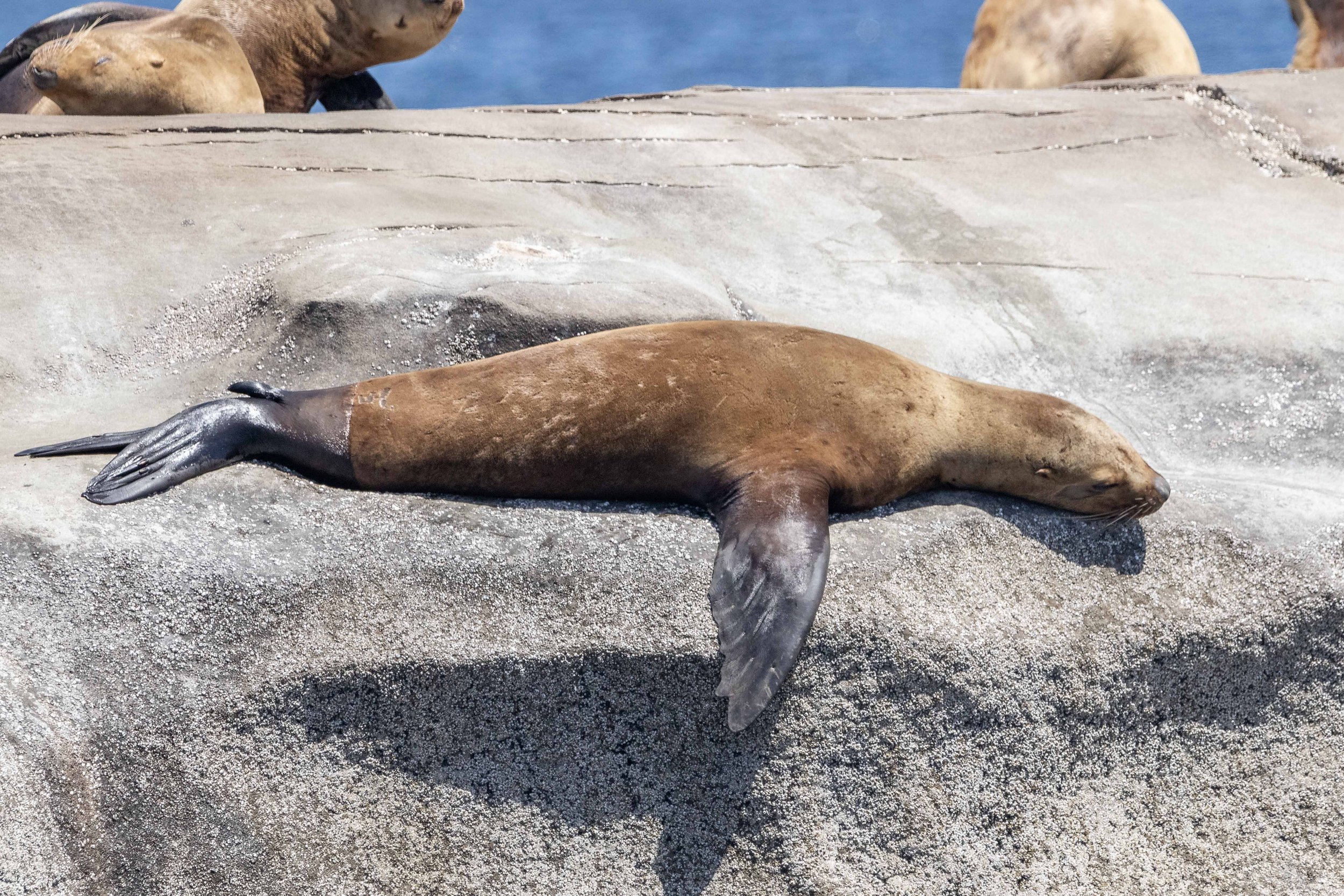June 12, 2024, 10:30am - Humpback Party in the Strait of Georgia
Another whale-y great day here in the Salish Sea! We headed out to the Strait towards an area becoming well known to us as Humpback feeding troughs, just outside of Porlier Pass near Valdes Island. We were very fortunate to find an abundance of humpbacks today, including Scuba (BCY1225), Beak/Nuage (BCX1606), Wormhole (BCX1275), Moresby (BCY0324 calf 2022), Graphite (BCX2077), and Harpy (BCZ0503).
We also got quite a bit of activity to watch today! 10-year-old Beak was feeling a bit slap-happy, showing off those nice long pectoral fins. These fins are massive and can reach up to 5m long when fully grown. They are also the reason behind the Humpback’s scientific name, Megaptera novaeangliae, which means “big-winged”. Not only did we see some slapping, but some belly-rolling as well. Looks like Beak was one excited guy! This kind of behaviour can be demonstrating play or excitement in the humpbacks, and can also be used as a form of communication between animals. This behaviour is especially important in the winter breeding grounds, where showing off is important in both males and females. Females will pec slap to encourage competition between males and effectively “rile them up” while also signalling their own readiness to mate. Males may also participate in big behaviours like pec slapping and breaching, as a way to flirt with females and show off their strength, while warding off other males in the area.
Besides showing off, these pec fins can also be used in the feeding process as well. In a 2019 article published by Kosma et al., Humpbacks in southeast Alaska have been seen “pectoral herding”. This involves using their pectoral fins to further corral fish and direct them while feeding, to make it easier for the whale to catch them. They can also use these giant airfoil-esque wings to disrupt the water flow, making it difficult for the fish to swim away. The final sneaky tactic these clever mammals use is dependant on the lighting conditions during feeding. On sunny days, the humpbacks can use the white ventral part of their pectorals to reflect the sun and effectively “flash” the schooling fish, causing them to swim away from the light and towards the open, dark mouth of the humpback. While they don’t get the hunting credit that orca do here in our waters, they still demonstrate complex feeding strategies that are super cool to learn about!
We love spending time with our humpback friends, and got to see a nice variety of humpbacks of various ages and fluke types! After our time was up, we headed to Stinky Rocks to see our pinniped buddies! We love observing the Steller Sea Lions as they congregate in their harems, they always have so much to say! The Harbour seals nearby are quite a bit more docile, preferring to quietly sunbathe in the calmer waters. Sometimes we luck out and see quite the menagerie st Stinky Rocks, and we got to see the River Otters today here as well! Other species we saw today include turkey vultures, cormorants and gulls!
Photos by Marine Naturalists Vanessa Vereschahen, Lucy Willis, and Hayleigh Hilbert.
This shows the scarring left from a previous entanglement on Scuba. Photo by Vanessa Vereschahen.
The underside of Scuba’s tail flukes. Photo by Vanessa Vereschahen.
Beak/Nuage creating a fluke waterfall! Photo by Lucy Willis.
Beak/Nuage surfacing in the waves! Photo by Lucy Willis.
Beak/Nuage lifting his Pectoral Fin out of the water. Photo by Lucy Willis.
Beak/Nuage with his pectoral fin in the air. Photo by Lucy Willis.
Can you tell this is all the same whale? Beak/Nuage is on his back with his tail visible on the left, and pectoral fins in the air on the right. Photo by Lucy Willis.
Beak/Nuage with both pectoral fins in the air! Photo by Lucy Willis.
Beak/Nuage continues to wave his pectoral fin. Photo by Lucy Willis.
Wormhole’s dorsal fin. Photo by Lucy Willis.
Wormhole creating a fluke waterfall as they prepare to dive. Photo by Lucy Willis.
The underside of Wormhole’s tail flukes. Photo by Lucy Willis.
Moresby going down for a dive. Photo by Hayleigh Hilbert.
A side view of Harpy’s tail flukes. Photo by Hayleigh Hilbert.
Moresby going for a dive. Photo by Hayleigh Hilbert.
Harpy’s dorsal fin. Photo by Lucy Willis.
Graphite going for a dive. Photo by Lucy Willis.
The underside of Graphite’s tail as he goes for a dive. Photo by Hayleigh Hilbert.
The top side of Graphite’s tail. Photo by Hayleigh Hilbert.
Graphite’s dorsal fin. Photo by Hayleigh Hilbert.
Moresby flicking his tail in the waves. Photo by Hayleigh Hilbert.
Graphite and Moresby travelling together. Photo by Vanessa Vereschahen.
A quick peak at the underside of Moresby’s tail. Photo by Vanessa Vereschahen.
Graphite creating a fluke waterfall. Photo by Hayleigh Hilbert.
Graphite’s tail flukes with the Vancouver Docks in the background. Photo by Vanessa Vereschahen.
Harpy’s very distinct dorsal fin. Photo by Hayleigh Hilbert.
A Steller Sea Lion laying on the rocks. Photo by Lucy Willis.
A very angry Steller Sea Lion on Stinky Rock. Photo by Hayleigh Hilbert.
A River Otter on Stinky Rocks. Photo by Lucy Willis.
Some Harbour Seals hauled out on the rocks. Photo by Hayleigh Hilbert.
Some Harbour Seals giving us the look as we watch them. Photo by Lucy Willis.
A gull with a Steller Sea Lion in the background. Photo by Vanessa Vereschahen.
This is a great example of the difference in look between a wet and dry Steller Sea Lion. Photo by Vanessa Vereschahen.
A pair of Cormorants on their nest. Photo by Hayleigh Hilbert.
A turkey Vulture keeping watch over the bluffs. Photo by Hayleigh Hilbert.
Some intertidal critters hanging onto the cliff. Photo by Hayleigh Hilbert.
Some very happy whale watchers on Kula. Photo by Hayleigh Hilbert.
Cascadia watching a humpback whale in the distance. Photo by Hayleigh Hilbert.






































